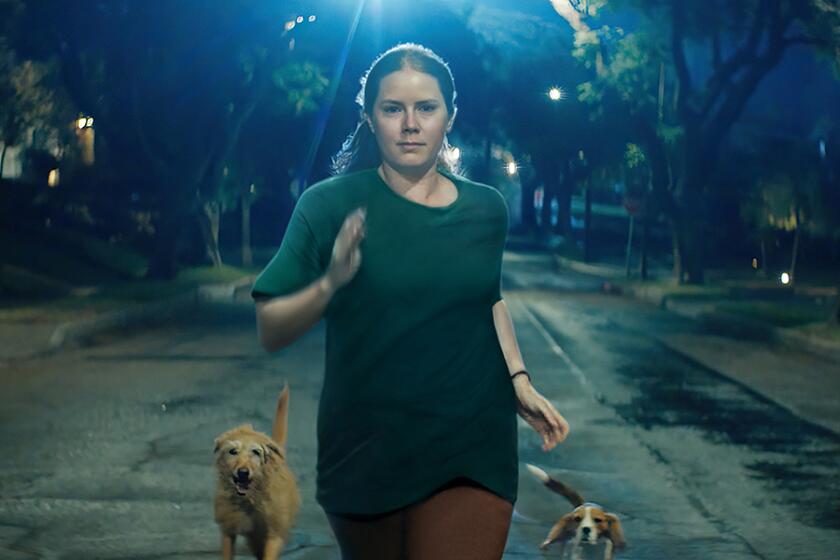MOVIE REVIEW : Kids Going Nowhere Fast in a Colombian Barrio
Not once in Victor Gaviria’s rigorous “Rodrigo D: No Future” (at the Monica 4-Plex) is there a reference to the sinister drug cartel that has made Colombia’s capital city of Medellin infamous. But its corrupting presence is felt in every frame of this film, which is suffused with the deadly calm of its makers’ anger.
“Rodrigo D.,” an important feature debut, is an uncompromising portrait of a poor Medellin teen-ager (Ramiro Meneses) and his friends. Not for Gaviria is the poetry of Bunuel’s “Los Olvidados” or the operatic quality of Hector Babenco’s “Pixote,” two films with which “Rodrigo D.” has been compared. Gaviria and his scenarist Elsa Vasquez steeped themselves for several years in the lives of Medellin’s pistolocos , a number of whom appear in the film and contributed to the development of the script.
Gaviria’s commitment to making a fictional narrative as painfully real as possible means that the rhythms of his film are set by the restless aimlessness of its people. He eschews the big dramatic scenes that might help draw us into his story. Neither he nor the kids tell us much about themselves. “Rodrigo D,” inspired by an actual Rodrigo, is a tough go and rightly so, for Gaviria wants us to feel what it’s like to be young and faced with virtually no opportunity to make anything of your life.
The compassion Gaviria feels for these young people is expressed in the discreet distance he maintains from them and in his refusal to sentimentalize their predicament. “Rodrigo D.,” shot by Rodrigo Lalinde, has the feel of fiction made documentary, and paradoxically, is beautiful and moving in its depiction of pervasive despair.
It is set almost entirely in a portion of the steep hills that surround Medellin. Rodrigo’s neighborhood has a raw, homemade look, but it is solidly constructed. The homes we visit are neat and clean. Nobody is starving. Yet there is little or nothing out there for the kids once they leave school, and the area is rife with crime and danger. The kids form gangs, and far more than each other, they fear the police, notorious for their brutality. This barrio could be anywhere in the world, including, obviously, Los Angeles.
Rodrigo stands slightly apart from his friends. Although despondent over the death of his mother and the loss of his construction job, he actually has a dream--of becoming a drummer and forming his own punk rock band. (The film’s frenetic punkero score is terrific.) As others all around him drift into petty--and soon not-so-petty--crime, Rodrigo tries to pursue his goal with as much determination as he can muster.
But “Rodrigo D” (Times-rated Mature for adult themes), which became the first Colombian film selected for the main competition at Cannes, is a film about kids going nowhere fast. As Gaviria, no doubt intends it’s almost impossible to work up much hope for its hero. Indeed, whereas Meneses, a musician and painter and here an actor of great concentration and focus, is now living in Bogota, at last report six of the film’s key actors are already dead, and two more are in prison.
‘Rodrigo D: No Future’
Ramiro Meneses: Rodrigo D
Carlos Mario: Resrepo Adolfo
Jackson Idrian: Gallego Ramon
Vilma Dias: Rodrigo’s Sister
A Kino International release of a co-production of Compania de Fomento Cinematografica (FOCINE)/Producciones Tiempos Modernos Ltda./Fotoclub 76. Director Victor Manuel Gaviria. Executive producer Guillermo Calle. Screenplay by Elsa Vasquez; based on an original idea of Gaviria, Luis Fernando Calderon, Angela Perez. Cinematographer Rodrigo Lalinde. Editor Gaviria, Luis Alberto Restrepo. Music German Arrieta.n Art director Ricardo Duque. Sound Sound Gustavo de Hoz. Running time: 1 hour, 31 minutes.
Times-rated Mature (for adult themes, some violence).
More to Read
Only good movies
Get the Indie Focus newsletter, Mark Olsen's weekly guide to the world of cinema.
You may occasionally receive promotional content from the Los Angeles Times.







